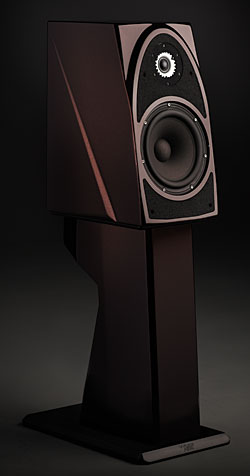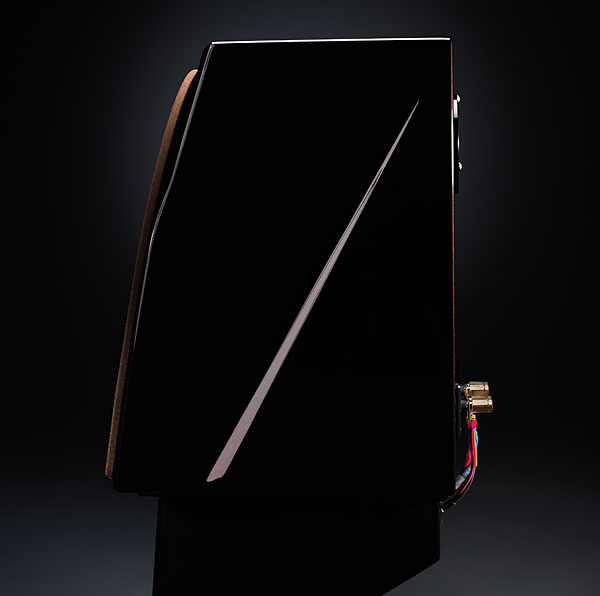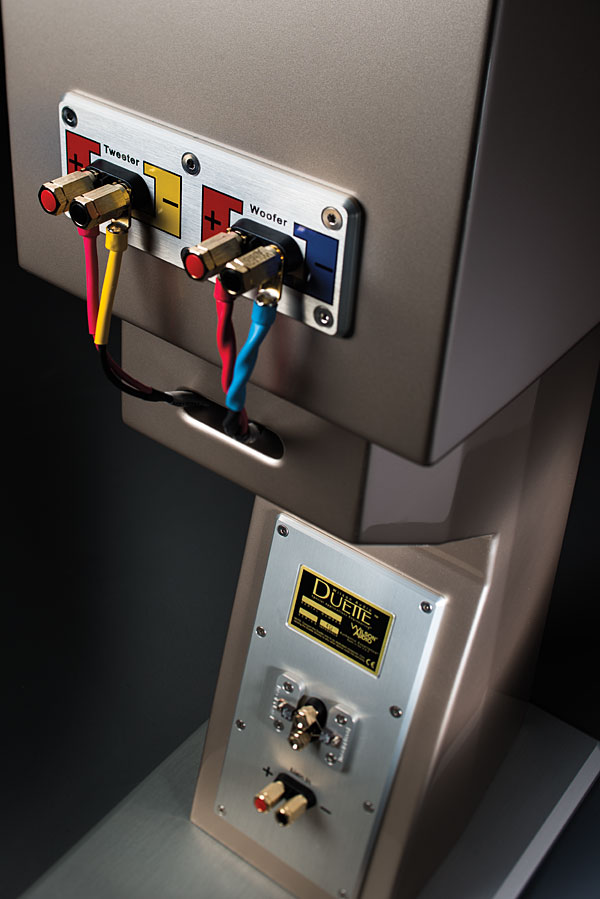| Columns Retired Columns & Blogs |
I like to see products like this, where the manufacturer isn't cutting corners in an attempt to broaden their market. There are a few people who have more money than interior space, and this is a good solution.
The Wilsons lacked the ability of the Altec Valencias—or the Wilson Sophia Series 3s—to sound really big when desired. Otherwise, and with a wide range of stereo material, they sounded spatially correct and pleasantly substantial. The latter quality was especially evident with simple stereo recordings—such as the Electric Recording Company's fine new reissue of Jean-Marie Leclair's (1703–1777) Sonatas 1 and 3 for two violins, played by Leonid Kogan and Elizaveta Gilels (LP, EMI/ERC SAX 2531). The violinists appeared to be standing just a few feet from one another, toward the center of an imaginary stage, yet remained clearly distinct from each other—stereo playback at its convincing best, in my opinion. When I felt like doing do, the Duettes rewarded close-up listening with an even greater sense of spatial depth; that said, I found the Wilsons more causally and comfortably convincing when enjoyed from a distance.
 I'm far more concerned about low-frequency performance—and far more discriminating, even though my system is pocked with mild irregularities and the low-frequency comb-filter effects they produce. In my room, the Duettes' deep-bass power and extension were surprisingly good for their size. Cellos sounded subjectively undiminished down to their lowest tones, as did timpani and most double-bass notes, while nearly full weight was given to the orchestral bass drum—as in Sir Adrian Boult and the New Philharmonia's recording of Elgar's The Dream of Gerontius (LP, EMI SLS 987). With pop and jazz recordings, electric and acoustic bass notes were more rounded than taut, with a bit less tactile impact than I like, but with no sluggishness or other timing distortions. A few notes in the midbass seemed too prominent: the D-flat (footnote 4) and the notes around it played by bassist Oscar Pettiford in Coleman Hawkins's recording of "Chant," from The Hawk Flies High (LP, Riverside/Original Jazz Classics OJC-027), as well as certain bass notes on good piano discs, including Clifford Curzon's recording of Liszt's Sonata in b (LP, Decca/Speakers Corner SXL 6076). Again, this slight unevenness of response was very likely room related, perhaps excited by the near-boundary installation.
I'm far more concerned about low-frequency performance—and far more discriminating, even though my system is pocked with mild irregularities and the low-frequency comb-filter effects they produce. In my room, the Duettes' deep-bass power and extension were surprisingly good for their size. Cellos sounded subjectively undiminished down to their lowest tones, as did timpani and most double-bass notes, while nearly full weight was given to the orchestral bass drum—as in Sir Adrian Boult and the New Philharmonia's recording of Elgar's The Dream of Gerontius (LP, EMI SLS 987). With pop and jazz recordings, electric and acoustic bass notes were more rounded than taut, with a bit less tactile impact than I like, but with no sluggishness or other timing distortions. A few notes in the midbass seemed too prominent: the D-flat (footnote 4) and the notes around it played by bassist Oscar Pettiford in Coleman Hawkins's recording of "Chant," from The Hawk Flies High (LP, Riverside/Original Jazz Classics OJC-027), as well as certain bass notes on good piano discs, including Clifford Curzon's recording of Liszt's Sonata in b (LP, Decca/Speakers Corner SXL 6076). Again, this slight unevenness of response was very likely room related, perhaps excited by the near-boundary installation.
So ends the sermon on space and bass. Perhaps unsurprisingly, the Duette Series 2 had considerably more than the above in its arsenal—and was exceptionally good at sorting out details from within dense recordings, dense arrangements, and dense recordings of dense arrangements. Perhaps no better example exists than the Kinks' Percy, music written and recorded for the 1971 film of that title (LP, Pye NSPL 18365): On lesser gear, it's nearly impossible to tell if the arrangement for the album's single, "God's Children," uses an orchestra, a Mellotron or two, an organ, or some combination of the three. The Duette Series 2 revealed the answer: orchestra and organ, but no Mellotron. I hasten to add that the Duette's abundant detail came not at the cost of brightness: Its treble, in quantity and quality, was in perfect keeping with the rest of its range. Indeed, the Duette was also nearly miraculously good—and far better than my Altec Valencias—at keeping LP surface noise from intruding on my listening.
The Wilson didn't produce the same forceful note attacks as the Altecs, but otherwise did an admirable job of maintaining listener involvement by communicating other elements of touch: the sense of the bow pulling off the string at the end of a note, the bouncy feel given a line of notes when a flatpicking guitarist relies on pull-offs rather than constant picking in an effort to increase speed, and so forth. The Duette 2 also revealed good snap and wallop in plucked bass viols and well-recorded (ie, uncompressed) drums, as I heard in "My Kind of Love," from Ella Fitzgerald's Ella Swings Lightly (LP, Verve MG VS-6019). And when pushed to dynamic extremes, the Wilson did not flinch. The recording, by Josef Krips and the London Symphony Orchestra, of Schubert's Symphony 9 (LP, Decca/Speakers Corner SXL 2045) showed off the Duette's ability to maintain full-color, noncrunchy poise during the loudest fortissimos. The Krips Schubert drove the combination of Shindo Corton-Charlemagne amplifiers and Wilson Duette Series 2s to glorious heights: strain-free peaks of beautifully textured strings and thunderous drums, with good scale—and the sort of musicality whereby, from the very first notes, I was compelled to follow the melody. Background music this was not.

The Wilsons' performance with mono recordings was distinctive, and the first example that comes to mind is a reissue on vinyl of the eponymous, mono-only debut album by Procol Harum (LP, Regal Zonophone/Classic LRZ 1001). Through the Duettes, B.J. Wilson's kick drum didn't have quite the same taut impact as through my Altecs, nor did the Duettes have the older speakers' very grand scale. But the Duettes handily exceeded the Valencias in two key regards: their ability to pull the lead vocal forward of the rest of the mono mix—listening to Gary Brooker sing "She Wandered Through the Garden Fence" was a complete delight—and their overall vastly superior clarity and detail.
On the other side of this coin was the way in which the Duettes presented the Electric Recording Company's well-loved reissues of Johanna Martzy's legendary recordings of J.S. Bach's sonatas and partitas for unaccompanied violin. Listening through the Wilsons to the ERC disc containing Sonata 3 and Partita 3 (EMI/ERC 33CX 1288), I was impressed with the instrument's texture and color, not to mention the natural momentum in each line of notes. But the Duettes' spatial qualities didn't suit this distinctly and unusually large mono recording of a single instrument. Rather than the entirety of the sound on the LP being pulled forward, the violin's position was splashy and indistinct, sometimes sounding as if located at the speaker enclosures themselves—which was a bit odd, and not in keeping with the Wilsons' otherwise creditable performance with mono records.
On the whole, my thoughts on the Duette Series 2 are best summed up with a record that's something of an audiophile chestnut whose musical and sonic transcendence make its use by many modern show exhibitors understandable: Louis Armstrong's version of "St. James Infirmary," from Classic Records' reissue of Satchmo Plays King Oliver (LP, Audio Fidelity/Classic AFLP 1930). The first thing I noted was the Duette's fine musicality, in particular its lack of pitch ambiguity. Just as important, with the Duettes in place, my system retained its momentum and flow, the lack of same being a common failing of lesser gear with very slow numbers such as this—like a cyclist falling over when not maintaining speed.
The Duette's strong suit on this recording was the way in which it nailed the timbral colors of instruments and voice alike, with generous and very realistic saturation: Anyone expecting the clinical and often bleached-out reproductions of timbres by other modern high-end gear will likely be surprised by the smallest Wilsons. The trombone plays a major role in this recording, and its sound—and scale—were convincing; similarly, each note of the modal clarinet improvisations had sonic and emotional weight, and was presented with a clarity that kept the instrument from stepping on Armstrong's vocal lines. Colorful clarity—the phrase occurred to me often during my time with the Duettes, with this and other recordings.

In their spatial reproduction of the Armstrong recording, the pair of Duettes surprised and pleased. Scale was fine: never quite huge, but realistically big without being grotesque. Instruments and voices were spatially distinct from one another while maintaining excellent senses of solidity and humanness (as opposed, I guess, to ghostliness). Solo instruments and Armstrong's voice appeared to arrive from an area slightly in front of the speakers themselves, while drums and piano remained distant, as appropriate. Best of all, the music didn't just lie still or flop over, as it does through so many modern speakers: The melody had real momentum and drive. Not just the sound, but the music was as exciting through the Duette 2s as through any other speakers I've heard.
Conclusions
Wilson Audio's Duette Series 2 is a specialized product: Not every audio enthusiast requires such a thing. That said, the Duette 2 is a specialized product that is especially noteworthy for fulfilling its singular task with degrees of competence and quality that make its superior difficult to imagine. And for $22,500/pair—an amount of money relatively few will ever be able to spend on a pair of small loudspeakers with stands, regardless of the patently obvious quality of the Duette's design, construction, finish, presentation, and support—that's precisely how it should be. That same amount of money will buy a pair of Wilson's Sophia Series 3s, which, as David and Daryl Wilson have said, is the preferable route for any hobbyist with enough space.
Loudspeakers designed for near-wall placement have come and gone over the years, offering different combinations of strengths. That the Duette Series 2 handily beats every one I've heard in terms of spatial performance will be germane to some; as far as I'm concerned, the more important consideration is the Duette 2s' overall musicality—their color, their clarity, their balance, and their ability to involve me as a listener, very much regardless of where they stand in the room. Space is valuable indeed, but musical pleasure is even more so—and on that count, the newest Duette looms large. Highly recommended.
Footnote 4: Interestingly, this is approximately 69Hz—nearly identical to a frequency associated with my room's 8' ceiling height.

I like to see products like this, where the manufacturer isn't cutting corners in an attempt to broaden their market. There are a few people who have more money than interior space, and this is a good solution.

These look like an update on the Ruark Equinox from the mid-90's. They are an absolute audiophile bargain if you can find someone to part with their pair.
http://www.stereophile.com/standloudspeakers/297ruark/index.html